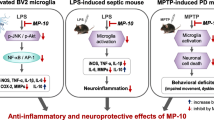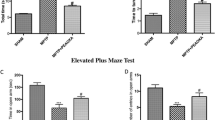Abstract
Inflammation is a ubiquitous factor accompanying normal aging and neurodegeneration, and recent studies indicate a major contribution of inducible cyclooxygenase (COX-2) and its downstream prostaglandin signaling pathways in modulating neuroinflammatory responses and neuronal function. We have previously shown that the prostaglandin PGE2 receptor EP4 suppresses innate immune responses in models of systemic inflammation. Here we investigated the role of the EP4 receptor in models of Parkinson’s disease (PD). Systemic co-administration of the EP4 agonist ONO-AE1–329 with the neurotoxin 1-methyl-4-phenyl-1,2,3,6-tetrahydropyridine (MPTP) prevented loss of dopaminergic (DA) neurons in the substantia nigra pars compacta (SNpc) without significant changes in glial activation, suggesting a potent neuroprotective effect of EP4 signaling in this acute model of DA neuronal loss. Cell-specific conditional ablation of EP4 in Cd11bCre;EP4lox/lox mice exacerbated MPTP-associated glial activation and T-cell infiltration in SNpc, consistent with anti-inflammatory functions of microglial EP4 signaling. In vitro, in primary microglia stimulated with oligomeric α-synuclein, EP4 receptor activation suppressed generation of pro-inflammatory and oxidative stress factors. Taken together, these findings suggest a dual neuroprotective and anti-inflammatory mechanism of action by the EP4 receptor in models of PD.




Similar content being viewed by others
References
Ahmad AS et al (2006) Prostaglandin EP1 receptor contributes to excitotoxicity and focal ischemic brain damage. Toxicol Sci 89(1):265–270
Andreasson K (2010) Emerging roles of PGE2 receptors in models of neurological disease. Prostaglandins Other Lipid Mediat 91(3–4):104–112
Block ML, Zecca L, Hong JS (2007) Microglia-mediated neurotoxicity: uncovering the molecular mechanisms. Nat Rev Neurosci 8(1):57–69
Boka G et al (1994) Immunocytochemical analysis of tumor necrosis factor and its receptors in Parkinson’s disease. Neurosci Lett 172(1–2):151–154
Brown GC, Neher JJ (2010) Inflammatory neurodegeneration and mechanisms of microglial killing of neurons. Mol Neurobiol 41(2–3):242–247
Burre J et al (2010) Alpha-synuclein promotes SNARE-complex assembly in vivo and in vitro. Science 329(5999):1663–1667
Chandra S et al (2005) Alpha-synuclein cooperates with CSPalpha in preventing neurodegeneration. Cell 123(3):383–396
Chung YC, Kim SR, Jin BK (2010) Paroxetine prevents loss of nigrostriatal dopaminergic neurons by inhibiting brain inflammation and oxidative stress in an experimental model of Parkinson’s disease. J Immunol 185(2):1230–1237
Dawson TM (2008) Non-autonomous cell death in Parkinson’s disease. Lancet Neurol 7(6):474–475
Fellner L et al (2013) Toll-like receptor 4 is required for alpha-synuclein dependent activation of microglia and astroglia. Glia 61(3):349–360
Frank-Cannon TC et al (2009) Does neuroinflammation fan the flame in neurodegenerative diseases? Mol Neurodegener 4:47
Gerhard A et al (2006) In vivo imaging of microglial activation with [11C](R)-PK11195 PET in idiopathic Parkinson’s disease. Neurobiol Dis 21(2):404–412
Griffin WS et al (2006) Interleukin-1 mediates Alzheimer and Lewy body pathologies. J Neuroinflammation 3:5
Hirsch EC, Hunot S (2009) Neuroinflammation in Parkinson’s disease: a target for neuroprotection? Lancet Neurol 8(4):382–397
Hunot S et al (1996) Nitric oxide synthase and neuronal vulnerability in Parkinson’s disease. Neuroscience 72(2):355–363
Johansson JU et al (2013) Suppression of inflammation with conditional deletion of the prostaglandin E2 EP2 receptor in macrophages and brain microglia. J Neurosci:Official J Soc Neurosci 33(40):16016–16032
Kawano T et al (2006) Prostaglandin E2 EP1 receptors: downstream effectors of COX-2 neurotoxicity. Nat Med 12(2):225–229
Klegeris A et al (2008) Alpha-synuclein activates stress signaling protein kinases in THP-1 cells and microglia. Neurobiol Aging 29(5):739–752
Klein C, Schlossmacher MG (2007) Parkinson disease, 10 years after its genetic revolution: multiple clues to a complex disorder. Neurology 69(22):2093–2104
Lees AJ, Hardy J, Revesz T (2009) Parkinson’s disease. Lancet 373(9680):2055–2066
Liang X et al (2005) Deletion of the prostaglandin E2 EP2 receptor reduces oxidative damage and amyloid burden in a model of Alzheimer’s disease. J Neurosci 25(44):10180–10187
Liang X et al (2008) The prostaglandin E2 EP2 receptor accelerates disease progression and inflammation in a model of amyotrophic lateral sclerosis. Ann Neurol 64(3):304–314
Liang X, Lin L, Wang Q, Woodling NS, Anacker C, Pan T, Merchant M, Andreasson K (2011a) Neuronal and vascular protection by the prostaglandin E2 EP4 receptor in a mouse model of cerebral ischemia. J Clin Invest 121(11):4362–4371
Liang X et al (2011b) Signaling via the prostaglandin E(2) receptor EP4 exerts neuronal and vascular protection in a mouse model of cerebral ischemia. J Clin Invest 121(11):4362–4371
Lotharius J, Brundin P (2002) Pathogenesis of Parkinson’s disease: dopamine, vesicles and alpha-synuclein. Nat Rev Neurosci 3(12):932–942
Lucin KM, Wyss-Coray T (2009) Immune activation in brain aging and neurodegeneration: too much or too little? Neuron 64(1):110–122
Mattammal MB et al (1995) Prostaglandin H synthetase-mediated metabolism of dopamine: implication for Parkinson’s disease. J Neurochem 64(4):1645–1654
McCormack AL et al (2002) Environmental risk factors and Parkinson’s disease: selective degeneration of nigral dopaminergic neurons caused by the herbicide paraquat. Neurobiol Dis 10(2):119–127
McGeer PL et al (1988) Reactive microglia are positive for HLA-DR in the substantia nigra of Parkinson’s and Alzheimer’s disease brains. Neurology 38(8):1285–1291
Mogi M et al (1994a) Interleukin-1 beta, interleukin-6, epidermal growth factor and transforming growth factor-alpha are elevated in the brain from parkinsonian patients. Neurosci Lett 180(2):147–150
Mogi M et al (1994b) Tumor necrosis factor-alpha (TNF-alpha) increases both in the brain and in the cerebrospinal fluid from parkinsonian patients. Neurosci Lett 165(1–2):208–210
Polymeropoulos MH et al (1997) Mutation in the alpha-synuclein gene identified in families with Parkinson’s disease. Science 276(5321):2045–2047
Pradhan S, Andreasson K (2013) Commentary: progressive inflammation as a contributing factor to early development of Parkinson’s disease. Exp Neurol 241:148–155
Qin L et al (2005) Microglial NADPH oxidase is a novel target for femtomolar neuroprotection against oxidative stress. FASEB J 19(6):550–557
Ransohoff RM, Perry VH (2009) Microglial physiology: unique stimuli, specialized responses. Annu Rev Immunol 27:119–145
Rocha NP et al (2014) Cognitive status correlates with CXCL10/IP-10 levels in Parkinson’s disease. Parkinson’s Disease 2014:903796
Shi J et al (2010) The prostaglandin E2 E-prostanoid 4 receptor exerts anti-inflammatory effects in brain innate immunity. J Immunol 184(12):7207–7218
Spillantini MG et al (1997) Alpha-synuclein in Lewy bodies. Nature 388(6645):839–840
Su X et al (2008) Synuclein activates microglia in a model of Parkinson’s disease. Neurobiol Aging 29(11):1690–1701
Taniguchi H et al (2011) Function of prostaglandin E2 EP receptors in the acute outcome of rodent hypoxic ischemic encephalopathy. Neurosci Lett 504(3):185–190
Taniguchi H et al (2014) Protection by vascular prostaglandin E2 signaling in hypoxic-ischemic encephalopathy. Exp Neurol 255:30–37
Tansey MG, McCoy MK, Frank-Cannon TC (2007) Neuroinflammatory mechanisms in Parkinson’s disease: potential environmental triggers, pathways, and targets for early therapeutic intervention. Exp Neurol 208(1):1–25
Villeda SA et al (2011) The ageing systemic milieu negatively regulates neurogenesis and cognitive function. Nature 477(7362):90–94
Woodling NS et al (2014) Suppression of Alzheimer-associated inflammation by microglial prostaglandin-E2 EP4 receptor signaling. J Neurosci: Official J Soc Neurosci 34(17):5882–5894
Yamada T, McGeer PL, McGeer EG (1992) Lewy bodies in Parkinson’s disease are recognized by antibodies to complement proteins. Acta Neuropathol 84(1):100–104
Zhang W et al (2005) Aggregated alpha-synuclein activates microglia: a process leading to disease progression in Parkinson’s disease. FASEB J 19(6):533–542
Acknowledgments
The authors would like to acknowledge Dr. Nathan Woodling and Dr. Xibin Liang for providing invaluable help in mastering the techniques and knowledge required to conduct this research. Thanks goes to Novie Ko for crucial assistance with the HPLC measurements. The authors also extend their thanks to the Stanford Human Immune Monitoring Center for providing equipment for the Luminex analysis and the Stanford Veterinary Service Center for providing the facilities necessary for housing the animals used in this research. Last but not least, the authors would like to thank Drs. Richard and Matthew Breyer (Vanderbilt University School of Medicine, Nashville, TN) for kindly providing C57BL/6 J EP4 lox/lox mice (Schneider et al., 2004) that were used in this study.
Author information
Authors and Affiliations
Corresponding author
Ethics declarations
Conflict of Interest
The authors declare that they have no conflict of interest.
Author Contributions
SSP designed and performed all MPTP and cell culture experiments, and prepared the manuscript. KS performed ELISA analysis of conditioned media from microglia and BV2 cells. ACG assisted with sectioning of brains, and immunostaining and image analysis of brain sections. JUJ performed isolation of the peritoneal macrophages used in this study and assisted in gene expression analysis. QW assisted with logistics of various experiments, in particular the luminex analysis of conditioned media from microglia. NK performed HPLC analysis of dopamine and associated metabolites from striatal brain sections. AMB collaborated on this study by lending stereology and HPLC equipment from her lab and advised in the design of experiments. KIA provided the resources to conduct the majority of experiments, and provided guidance on experimental design and manuscript preparation. All authors have read and approved the final version of the manuscript.
Rights and permissions
About this article
Cite this article
Pradhan, S.S., Salinas, K., Garduno, A.C. et al. Anti-Inflammatory and Neuroprotective Effects of PGE2 EP4 Signaling in Models of Parkinson’s Disease. J Neuroimmune Pharmacol 12, 292–304 (2017). https://doi.org/10.1007/s11481-016-9713-6
Received:
Accepted:
Published:
Issue Date:
DOI: https://doi.org/10.1007/s11481-016-9713-6




